Summary
The relationships between \(\dot V_{O_2 } \) at rest, \(\dot V_{O_{2max} } \) and \(\dot V_{O_2 } \) during submaximal work on a treadmill with body weight, height and lean body mass assessed by densitometry were analyzed annually in 39 boys aged 11 to 18 years. Interindividual differences in \(\dot V_{O_2 } \) at rest and \(\dot V_{O_{2max} } \) during growth depended in the first place on interindividual differences in lean body mass, to a lesser extent on differences in body weight and least on differences in height. Intersubject differences in \(\dot V_{O_2 } \) during submaximal work were primarily conditioned by differences in body weight, due to the fact that, at a given running speed, energy output depends on body weight. The differences in submaximal \(\dot V_{O_2 } \) depended to a lesser extent on differences in lean body mass and least on differences in height. The relationships between \(\dot V_{O_2 } \) increments and increases in body dimensions were somewhat different in 90 boys between the ages of 11 and 15 years: \(\dot V_{O_{2max} } \) increments were determined primarily by changes in body weight and height, changes in lean body mass being of secondary importance. Increases in submaximal \(\dot V_{O_2 } \) were influenced decisively by increments in body weight, followed by increments in lean body mass and least by increments in height. In the equation y=a·x b expressing the relationship of \(\dot V_{O_{2max} } \) at the ages of 14 and 15 years were 0.87 and 0.88 in relation to body weight, 2.63 and 2.72 in relation to height. These values are significantly higher than the theoretical values of 0.67 for body weight and 2.00 for height. Similar significant differences from these theoretical values were found for all values between the ages of 11 and 15 years.
Similar content being viewed by others
References
Arshavskij IA (1964) Osobennosti energetiki, dinamitsheskaja aktivnost muskulatury i poverchnost tela. VII. Mezhduna-rodnyj kongr. antropol. etnograf. nauk. Nauka, Moskva
Asmussen E, Heeboll-Nielsen K (1955) A dimensional analysis of physical performance and growth in boys. J Appl Physiol 7: 593–603
åstrand PO (1952) Experimental studies of physical working capacity in relation to sex and age. Munksgaard, Copenhagen
åstrand PO, Rodahl K (1977) Textbook of work physiology. McGraw-Hill, New York
Buskirk E, Taylor HL (1957) Maximal oxygen intake and its relation to body composition, with special reference to chronic physical activity and obesity. J Appl Physiol 11: 72–78
Döbeln W (1956) Human standard and maximal metabolic rate in relation to fatfree body mass. Acta Physiol Scand [Suppl] 37: 126
Döbeln W, Eriksson BO (1972) Physical training, maximal oxygen uptake and dimensions of the oxygen transporting and metabolizing organs in boys 11–13 years of age. Acta Paediatr Scand 61: 635–660
PaŘízková J (1961) Age trends in fat in normal and obese children. J Appl Physiol 16: 173–174
šprynarová š (1974) Longitudinal study of the influence of different physical activity program on functional capacity of boys from 11 to 18 years. Acta Paediatr Belg [Suppl] 28: 204–213
šprynarová š, Reisenauer R (1977) Body dimensions and physiological indicators of physical fitness during adolescence. In: Physical fitness assessment, Ch. Thomas, Springfield, pp 32–38
šprynarová š (1987) The influence of training on physical and functional growth before, during and after puberty. Eur J Appl Physiol 56: 719–724
Weber E (1957) Grundrisse der biologischen Statistik. Gustav Fischer, Jena
Welch BE, Rindeau RP, Crisp CE, Isenstein RS (1958) Relationship of maximal oxygen consumption to various components of body composition. J Appl Physiol 12: 395–398
Wyndham CH, Heyns AJ (1969) Determinants of oxygen consumption and maximum oxygen intake of Bantu and Caucasian males. Int Z Angew Physiol 27: 51–75
Author information
Authors and Affiliations
Rights and permissions
About this article
Cite this article
šprynarová, š., PaŘízková, J. & Bunc, V. Relationships between body dimensions and resting and working oxygen consumption in boys aged 11 to 18 years. Europ. J. Appl. Physiol. 56, 725–736 (1987). https://doi.org/10.1007/BF00424817
Accepted:
Issue Date:
DOI: https://doi.org/10.1007/BF00424817




